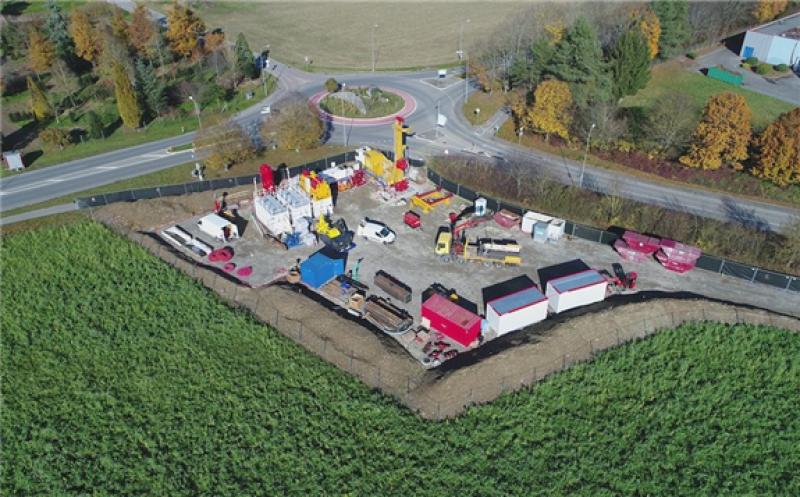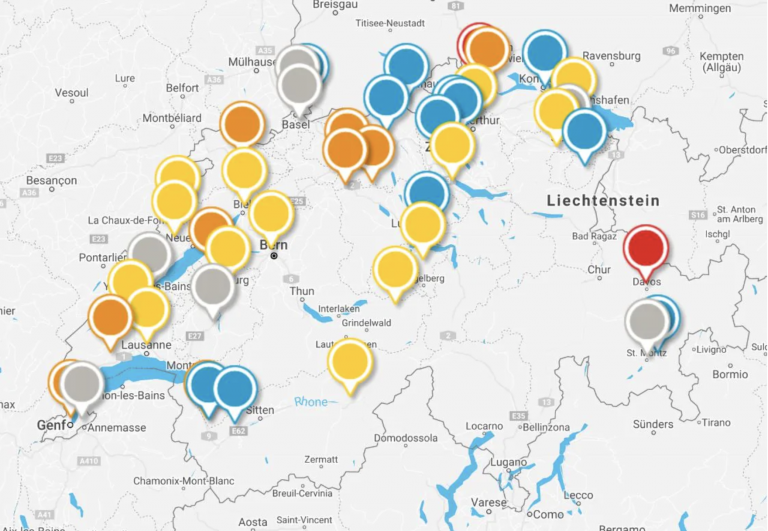 Project site at Satigny, Geneva, Switzerland (source: GEothermie 2020)
Project site at Satigny, Geneva, Switzerland (source: GEothermie 2020)
After the small earthquakes in Basel in 2006 and in St. Gallen in 2013, deep geothermal energy was the subject of intense debate in Switzerland. So the question today is how and if geothermal energy can help the country meet its ambitious energy and climate goals?, so an article by SwissInfo last month.
At the ultramodern Lancy-Bachet station in central Geneva, passengers await the next Léman Express, the new regional cross-border train. Dim lights loom on the horizon and the convoy slowed down before halting. Unbeknownst to travelers, the heat generated by the train and its squeaky brakes is captured under the rails and in the walls of the tunnel. It will be used to heat and cool neighboring apartments and offices.
The system – currently a pilot project – operates using polyethylene pipes filled with heat transfer fluid which are embedded in a 100-meter section of the new tunnel. This energy source is connected to a pump capable of producing heat and cold, which is then injected into the district heating network.
This is one of the many innovative geothermal projects emerging in Switzerland in an attempt to meet ambitious energy and climate goals. In Geneva, the government wants the new buildings to operate at 80% using renewable energy. And by 2035, 20% of the township’s heating needs are expected to come from geothermal sources.
The Lancy-Bachet project is a Swiss first. It is in line with pioneering projects such as Genilac, a heat exchange project that uses water from Lake Geneva to cool and heat buildings. This is Geneva’s contribution to the European underground thermal energy storage project, HeatStore. Bern and Zurich have similar storage projects.
Geneva also continues to explore the underground to find geothermal energy. The federal authorities recently released CHF27.5 million to finance drilling. Some of this silver is used at the Lully test site, where engineers drilled 1,456 meters below the earth’s surface. The boiling water that gushes out at a temperature of 53 degrees Celsius and its pressure is appropriate, but it has a low flow rate, experts say. It is therefore not hot enough or powerful enough to produce electricity, but it can be used to heat buildings.
Geneva is extremely pioneering in thermal energy, according to Gunter Siddiqi, researcher at the Federal Office of Energy. “There is a combination of political will, business acumen and expertise in research and innovation,” he says, while stressing that the conditions in each canton are different and that it is not not certain that the Geneva model can be reproduced elsewhere in Switzerland.
Currently, geothermal activities are limited to the extraction and storage of thermal energy, primarily by means of vertical heat exchangers, groundwater wells, geothermal structures and hot tunnels. These are normally used in combination with a heat pump for heating and, in some cases, cooling.
Across Switzerland, almost 15% of heating systems in homes, offices and other buildings use such geothermal heat pumps. In 2019, the Federal Office of Energy recorded 102,000 underground probes in operation, which represents the “highest concentration per square kilometer in the world”.
Overall, shallow geothermal heat production covers only 1.3% of the country’s heating needs. But the technologies are well established and the federal authorities, as part of the 2050 energy strategy, are convinced of their advantages and potential.
Elmar Grosse Ruse, climatology expert at WWF Switzerland, is optimistic about their further development. “We are committed to getting rid of fossil fuels for heating over the next two decades and this will only be possible if we use a lot of heat pumps in densely populated areas,” he said. .
Gunter Siddiqi also expects the use of these technologies to increase in the years to come. He believes that the underground probes could be placed at greater depths. However, he insists on the need to maintain safety distances (10-12 meters) between them to prevent systems from competing to capture underground heat.
Renewable energies and geothermal production in Switzerland
In Switzerland, geothermal energy is not currently used to generate electricity. The United States is currently the world’s largest producer of geothermal electricity, with the state of California covering about 5% of its electricity needs in this way. All of Switzerland’s neighboring countries also produce geothermal power.
The Federal Office of Energy assures us that Switzerland will soon follow suit. He estimates that by 2050, 7% of national electricity consumption will be covered by geothermal energy.
To achieve this, a geothermal power plant would have to extract water at over 100 degrees Celsius 3000 – 4000 meters below the earth’s surface using advanced techniques. But scientists have little knowledge of the local geological conditions in the depths of Switzerland and the exploration phase of geothermal projects is expensive.
Several deep drilling projects have suffered setbacks. In 2006 and 2013, teams from Basel and St. Gallen injected a pressurized liquid into a hot, dry and impermeable rock located at depth to create an artificial geothermal reservoir. But they had to give up, when the stimuli triggered minor earthquakes.
New in-depth initiatives
Today, new tests are launched in different regions of Switzerland, to prospect the deep subsoil in search of energy sources.
One of these projects in Haute-Sorne, in the canton of Jura, made headlines in April, when the cantonal government announced its wish to revoke its authorization, reacting to concerns expressed by the local population about the risks of this technology. This change of course, however, aroused general dismay among geothermal energy advocates and the Swiss government. “Stopping this project would be a blow to other geothermal power plant projects in Switzerland and send the wrong signal, especially to investors interested in other sites,” the government said recently.
Gunter Siddiqi admits that Switzerland lags behind other countries when it comes to geothermal power generation. However, he believes that the country has no other choice but to continue to explore and invest in such projects to achieve its renewable energy objectives.

An overview of deep and medium geothermal projects underway in Switzerland. Legend of map symbols: yellow (exploratory studies); orange (planning phase); red (under construction); blue (in use); gray (canceled). Geothermie-Schweiz.ch